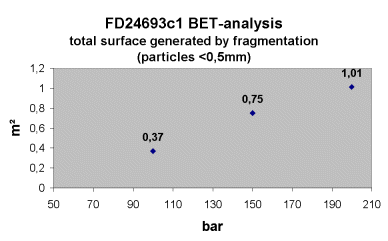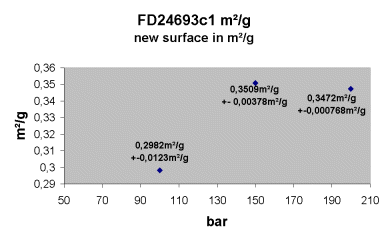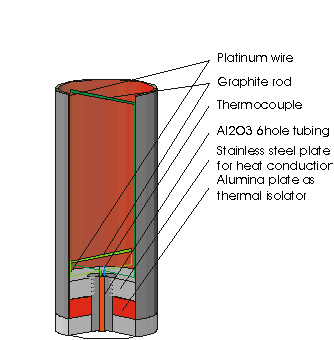

Granulometric measurements of experimentally generated pyroclasts (EP) in the fragmentation apparatus revealed a loss of fine particles and a contamination of small grain-size-fractions due to the design and coating of the old low-pressure tank. Consequently, a new gas-tight low-pressure tank (LPT) was designed and brought into service. The new stainless steel LPT allows the application of new analytical techniques. Of particular note, surface area measurements (BET) on the fine fraction have been able to verify for the first time pressure-controlled grain size limits for experimentally generated pyroclasts (Fig. 3.7-8a,b).
Due to the large size of the phenocrysts (up to 10 mm) in the dacite of Unzen, participation in the UNZEN project required the development of a system capable of handling a larger sample size than was previously possible. In this way, the diameter of the sample was increased to 26 mm and the length to 60 mm, giving a 2.8 times larger sample volume. By adding a 5 mm "alsint" disc under the sample holder we were able to decrease the temperature gradient of the sample to 12°C. To minimise the excess gas volume the inner diameter of the autoclave was reduced to 10 mm under the sample. The gas supply system and the diaphragms were adapted to the new requirements.
 |
 |
Fig. 3.7-8a: This diagram illustrates the total surface area (m2) of fine particles generated by a rapid decompression vs. the pressure (bars) applied to the sample. |
Fig. 3.7-8b: In a plot of the measured surface area (m2/g) vs. pressure (bars), a pressure limit exists beyond which the generated grains do not develop a larger surface area. |
The development of a new technique for measurement of fragmentation speeds at high-temperature represents a further major step in the investigation of magma fragmentation. Fragmentation speed measurements in the "fragmentation bomb" at temperatures up to 100°C were performed using a set of PCB dynamic pressure transducers. In this technique (Fig. 3.7-9), two holes are drilled perpendicular to the long axis of the cylinder through the sample, so
 |
Fig. 3.7-9: Schematic side view of the sample cell for measurement of fragmentation speeds at high temperatures. Two graphite rods used as electrical conductors are placed at known distances through the sample. |
that two graphite rods can be placed as electrical conductors in the path of the fragmentation. Potentials of 5V DC applied to each of the graphite rods are monitored using a computer. The fragmentation front first breaks the upper graphite rod, disconnecting the 5V potential. This is followed by the breakage of the second graphite rod and a second loss of potential. The time between the two signal losses allows calculation of the speed of the fragmentation front. The new technique permits analysis of the influence of temperature and consequently of viscosity on fragmentation behaviour. Such results are important for the modelling of dome collapse and magma fragmentation in the conduit of a volcano.

Tel: +49-(0) 921 55 3700 / 3766, Fax: +49-(0) 921 55 3769, E-mail: bayerisches.geoinstitut(at)uni-bayreuth.de
 Previous page
Previous page